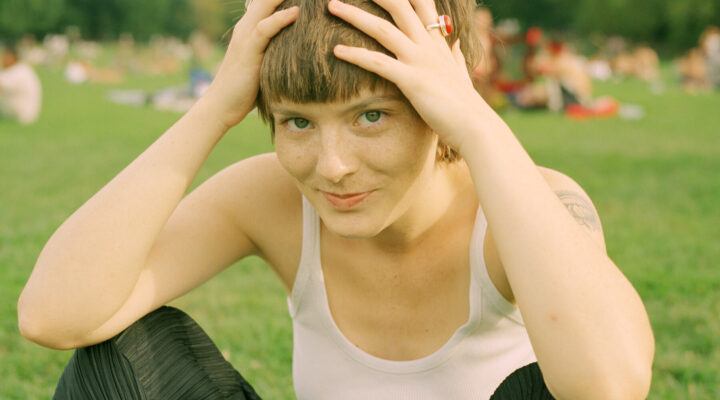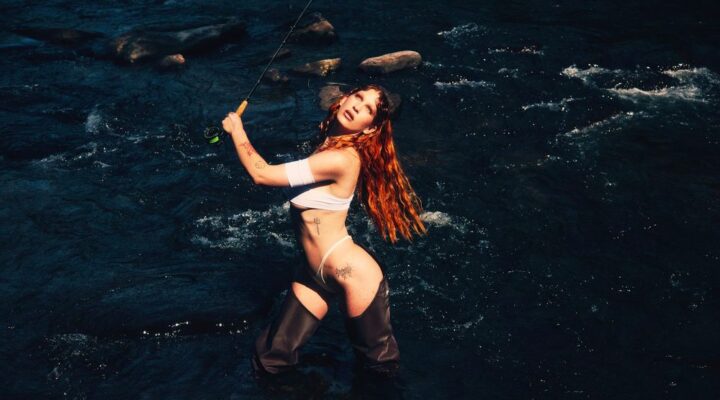An Interview with Irreversible Entanglements
by Luca Bruls
Band photo credits: Bob Sweeney
Cover credits: Damon Locks (Self-titled), Cyrus Moussavi (Open the Gates) & Big Flowers (Down to Earth)
At heart, Irreversible Entanglements is an improvisers’ band. The five-headed collective coaligned in New York in 2015, whereafter they received wide acclaim for their poetic, liberating jazz. They deliver their resolute sounds evocatively, asking their audiences to elevate and process. Their music comes from a sense of social practice and aims to articulate and create community. Ahead of their concert in BIMHUIS in collaboration with The Rest is Noise I spoke with Keir Neuringer (saxophone, percussion) and Aquiles Navarro (trumpet, percussion) on physicality, healing, and world-building as communal practices.

The title of your most recent album Open The Gates invites your audience to move along with what is behind closed doors. What do you aim your audience to find in this destined world?
Keir Neuringer: On one level what we do, is what poetry does. Which is evocation. Open The Gates could be interpreted, especially given the time that it was recorded, as a question to open which gates? We recorded the album while most of the world was in lockdown. But Open The Gates doesn’t mean thát specifically. What it does mean, is that the improvised music we make, is music of liberation. So this phrase “Open The Gates” is a demand. It is a determination. That we, as a band and as people, are moving in liberation. We’re carrying on a tradition. Every move we make is in some form a poetic evocation of our values and our determinations in the world. We’re determined to be free and push back. Take the tracks Lágrimas Del Mar or Water Mediation. They express somberness, real tears and the heartbroken. Whereas, the title track Open The Gates is joyful.
Aquiles Navarro: When we are improvising together, we are channelling this energy to manifest something. Indeed, Open The Gates sounds more joyful, at the same time with Tcheser (Holmes) on percussion (and drums, red.) it’s really powerful. We needed a tune to kick the door open and Tcheser was ready to provide it. Boom! But, Open The Gates also means to go home, to be at home, to know where you come from.
K: Importantly, we did not set out to make an album titled Open The Gates. We simply went to the studio knowing we wanted to make something healing. We booked studio time and created. Only afterwards we realized the dominant themes and thought of how to present them.
The visual language that you use for your videos and album covers seems very layered. How do you work with the different mediums of sound and image?
A: It’s definitely a feeling. We have to feel something from whomever we work with.
K: Yes, trusted collaborators like Damon Locks – who did the first two album covers, Bob Sweeney – who took the pictures at the studio for the third album, Imani Nikyah Dennison – who did the video for No Más, and Cyrus Moussavi – who did the video for Open The Gates. If we have a good feeling about someone, we tell them: listen to the music, go, and come back when you have something. Our music, because of Camae and her poetry, but also sonically, evokes pictures. So, when we offer our sound to collaborators, they will often come back with inspired pictures.
A: It’s not as if we’re working with a huge budget. But, we never give commands to the artists we work with. We collaborate. We trust people’s work and the result is organic. Like with Imani; she happened to be in South Africa for the No Más video.
K: It’s true, we work from scarcity, but are rich in community. And, our community is well-tuned into our music to know that the images need to bring together the past, present, and future.
When you’re performing on stage, the visual display of bodily motion and physical gestures contribute to how you express information, or how you express your music. How do you incorporate that medium?
A: The spirit takes over. It’s the channelling of energy. The body looks for the best way to be efficient; to find where the spirit wants to go. Sometimes I like to wear sunglasses, because it feels like I can disappear and get a sense of privacy. It’s a way to synthesize the sound through body and movement, without sacrificing focus and moving too much.
K: When we hang out as a band there’s always music. We have a physical relationship to it. I know dance is integral to Tcheser and the way he experiences and thinks about music and culture. But Tcheser does not move as much as I think he would if the instrument allowed him to. Moreover, when we feel good after a show, we put on music backstage and Luke is the first one to be on the dance floor. Camae definitely also has a relationship to movement. I recall when we played Music Unlimited in Wels. Everyone was sitting down with masks, and Camae said: “You are allowed to move.” It was like an ‘open-the-gates’ moment. She kept on saying this phrase, until the end of the show this festival audience was on their feet, up in front. There were people coming up on stage, dancing there. Another time, we played in Berlin for a seated audience. There was a 12-year old boy in the front row, who we noticed never to stop moving. He was so tuned in to the drums. When it was time for an encore, Tcheser said: “You come up and play the drums.” There was no understanding if he played drums or wanted to, but Tcheser saw there was a physical relationship that needed to be acknowledged. The boy came up and played the drums with absolute delight. We opened the gate for the boy, but also for ourselves. We had never done that before. That is a moment of risk, freedom and vulnerability, but also of joy.
Some people say that music is kind of like conversation – be it human chatter, singing birds, or far-traveling songs in the form of echolocation by dolphins. How do you make use of that conversational space?
K: In the first gig we played post-pandemic, I noticed the sound engineers, the stagehands, and all of the support staff had so much goodwill. Everyone was happy to be there and work together. It made me think about how we all make the concert happen. If everybody approaches it with a sense of desire and goodwill, events can impact people deeply. When we stand on stage it’s not unilateral. As if we push the sound outwards to the audience, who take it in, and then that’s the end of the conversation. Instead, the conversation is a spiritual human mass. People bring their shit to a show. Somehow, they’re going to process that within that time, and hopefully get through it elevated.
A: As an improvising group, there are five people on stage. Our music says something, because it has been through history. It has been through different journeys. We inform one another with our presence and make audible what it was like during my journey. These five stories come together in the present.
How do you use silence in music-making?
A: Right before I go on stage, silence is in my own mind. We open up with silence, simply stand there and meditate. We would love to use silence more, but it’s the time, and we have the energy, to speak up. I love the feeling that as you grow older, you can embrace that less is more. It’s because you earn the silence. You earn the space. You don’t have to do much to say a lot. That comes with time and longevity.
K: Silence is implied as the end of music. Not to be morbid, but similarly death is implied as the end of life. If I’m playing solo saxophone, I might play for 45 minutes without there being a physical silence, but there are implied silences as activity shifts. In our quintet, there may be moments where we don’t hear Camae for example. That is one form of implied silence – even though there might still be dense sound happening. Often before we go on stage, when we’re sitting backstage, Luke will turn off all the lights, things will get quiet.
A: We all have these rituals and silences are a strong gradient of it. Silence gives value to what you have to say. So, we are constantly giving that space to each other. Silence can be uncomfortable, when you have to learn how to deal with it. But when you learn to do so, you will feel more confident.
In your musical descriptions and lyrics you often refer to the four elements of earth, water, fire, and air. What’s your intention with referencing these different layers?
K: That’s actually a question for Camae, as the specific word references come from her. But from the perspective of a listener and collaborator, one interpretation is that she references basic elemental things, the building blocks of the universe. Everything else, about human interaction and social behaviour, happens among those fundamentals. These four elements touch us all, as well as all of the beauty, love, anger. I read Camae’s taking things down to the elemental level as a way for her to evoke specific ideas and pictures with a kind of universal resonance. She builds a world, makes you feel something out of the context of that world.
A: When we play, I listen to the words. But sound has a way of carrying. It travels too fast to allow me the time to interpret Camae or give reasoning to her words. So, I let my body take over. The power of the sound that carries the messages enables us to process what seems literal into a feeling.
K: Scottie McNiece, from International Anthem, noticed that our second album deals a lot with ritual. We did not talk about that beforehand, but it was just in our minds. About our recent album, he said: “This is a water album.” I feel that in terms of references, Open The Gates is a water album. I would say that our first album is the fire album. Both albums touch every layer, but the last one is definitely water-heavy, which is interesting as we talk about healing.
A: Also, everyone was limited to going to the beach during COVID. It was the water calling you. And, it doesn’t stop. You sit on the beach and the ocean will outlive you [imitating the sound of ebb and flow]. The water flows continuously at night: day in, day out. We go through this motion and we synthesize things that we pay attention to in the world. That’s how we come together in agreement.
BIMHUIS & The Rest is Noise have invited Irreversible Entanglement to play in BIMHUIS on the 20th of June. There are a limited amount of free tickets for Subbacultcha members. Find more info on the concert + attendance here.







